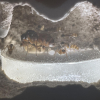They have social stomachs, but really small ones. They like to bring their sugar sources back on bits of debris. Chocolate is not a particularly good sugar source for ants -- they should be receiving sugar dissolved in water.
Edited by Batspiderfish, October 1 2017 - 4:56 AM.
If you've enjoyed using my expertise and identifications, please do not create undue ecological risk by releasing your ants. The environment which we keep our pet insects is alien and oftentimes unsanitary, so ensure that wild populations stay safe by giving your ants the best care you can manage for the rest of their lives, as we must do with any other pet.
Exotic ants are for those who think that vibrant diversity is something you need to pay money to see. It is illegal to transport live ants across state lines.
----
Black lives still matter.

















